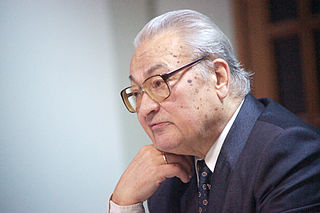
Minsk is the capital and the largest city of Belarus, located on the Svislach and the now subterranean Niamiha rivers. As the capital, Minsk has a special administrative status in Belarus and is the administrative centre of Minsk Region (voblast) and Minsk District (raion). As of January 2021, its population was 2 million, making Minsk the 11th most populous city in Europe. Minsk is one of the administrative capitals of the Commonwealth of Independent States (CIS) and the Eurasian Economic Union (EAEU).

At the top level of administration, Belarus is divided into six oblasts. The city of Minsk, has a special status as the capital of Belarus. Minsk is also the capital of Minsk Region.

The BPF Party is a political party in Belarus. It was de facto established after the split of the social movement Belarusian Popular Front in 1999. The Belarusian Popular Front was founded during the Perestroika era by members of the Belarusian intelligentsia, including Vasil Bykaŭ. Its first and most charismatic leader was Zianon Pazniak.

Kurapaty is a wooded area on the outskirts of Minsk, Belarus, in which a vast number of people were executed between 1937 and 1941 during the Great Purge by the Soviet secret police, the NKVD.

The Belarusian Popular Front "Revival" was a social and political movement in Belarus in the late 1980s and 1990s which led Belarus to its independence from the Soviet Union. It was similar to the Popular Fronts of Latvia and Estonia, and the Sąjūdis movement in Lithuania.

Zianon Stanislavavič Pazniak is a Belarusian nationalist politician, one of the founders of the Belarusian Popular Front and leader of the Conservative Christian Party – BPF. He was the Belarusian Popular Front nominee for President of Belarus in the 1994 election.

Dinamo National Olympic Stadium is a multi-purpose stadium in Minsk, Belarus. It was reopened after a renovation project. Earlier it was used mostly for football matches and was the home ground of Dinamo Minsk, FC Minsk and the Belarus national football team. Previously the stadium officially held 40,000, but because part of the upper stand had been abandoned in the mid-1990s for safety reasons, the actual capacity before renovations was 34,000. After renovation the capacity is only 22,246.

Belarusian Americans are Americans who are of total or partial Belarusian ancestry.

Hienadz Buraukin was a Belarusian poet, journalist and diplomat.
Iwye District is a district (rajon) in Grodno Region of Belarus.

Raman (Roman) Skirmunt was a Belarusian and Polesian statesman, aristocrat and landlord. Patron, significant landowner, vice-chairman of the Minsk Agricultural Society. Deputy (1906) of the First State Duma of the Russian Empire; deputy (1910-1911) of the State Council of the Russian Empire from the Minsk province; (nominal) Prime Minister of the BNR (1918) — was not approved for the post of Prime Minister; senator of Poland (1930-1935). His cousin Konstanty Skirmunt was a notable Polish diplomat and minister of foreign affairs.

The Belarusian State Academy of Arts is a state-owned institution of higher education in Minsk, Belarus. The Belarusian State Academy of Arts has status as a leading institution of the national system of art and cultural education alongside the Belarusian State Academy of Music and the Belarusian State University of Culture and Arts.

Chernobyl Way is an annual rally held on April 26 by the opposition in Belarus as a remembrance of the Chernobyl disaster.

The Belarusian opposition consists of groups and individuals in Belarus seeking to challenge, from 1988 to 1991, the authorities of Soviet Belarus, and since 1995, the leader of the country Alexander Lukashenko, whom supporters of the movement often consider to be a dictator. Supporters of the movement tend to call for a parliamentary democracy based on a Western model, with freedom of speech and political and religious pluralism.

Siarhei Iosifavich Navumchyk is a Belarusian journalist and politician.

Belarusian nationalism refers to the belief that Belarusians should constitute an independent nation. Belarusian nationalism began emerging in the mid-19th century, during the January Uprising against the Russian Empire. Belarus first declared independence in 1917 as the Belarusian Democratic Republic, but was subsequently invaded and annexed by the Russian Soviet Federative Socialist Republic in 1918, becoming part of the Soviet Union. Belarusian nationalists both collaborated with and fought against Nazi Germany during World War II, and protested for the independence of Belarus during the late 1980s and early 1990s.
Viera Cierliukievič was one of the most prominent Belarusian female political and trade union activists in the 1990s, identified among “heroic women in the history of Belarus”.
The "Minsk Spring" or "Belarusian Spring" was a series of mass street protests in 1996 and 1997 against the increasingly-authoritarian rule of President Alexander Lukashenko.

The Church of Saint Mary in Miadziel, Belarus, is a Catholic church, listed as a Cultural Heritage object. The church was constructed in 1754 for the Discalced Carmelites' monastery.

The 1999 Belarusian presidential election was a political protest action by members of Belarusian opposition who did not recognise the 1996 constitutional reform which extended Alexander Lukashenko's presidential term.
















